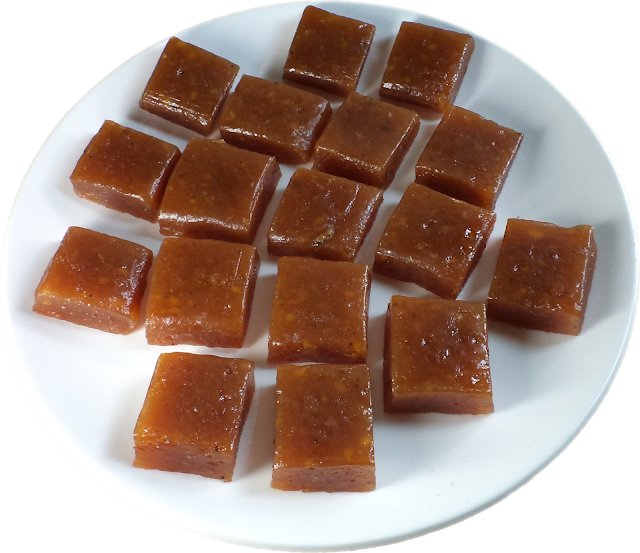PURE
BANANA HALWA
A HEAVENLY DESSERT
Introduction:
Malayalis as a whole are mad about Nendran banana halwa. Keralites
visiting relatives abroad almost invariably carry Nendran banana chips
and Nendran banana halwa as prized gifts for loved ones. For preparing this
superb banana halwa, no other variety of banana can be used simply because
Nendran banana is equal to Nendran banana alone. You will realize this fact
when you eat it.
That is why the farmers in Kerala simply ignore even the Robusta
varieties which yield 50 to 60 kilo bunches in preference to cultivating Nendran
banana plants which yield just 12 to 15 kilo bunches. If you wish to eat pure
banana halwa, you have to make it at home.
Commercially available banana halwa, sold in many bakeries
all over Kerala generally contains a whole lot of Maida (refined white wheat
flour), cheap hydrogenated vegetable oil and artificial food colour with a
little banana added for the necessary flavor and taste.
For making banana halwa, you need Nendran bananas that are so
ripe that the naturally golden yellow skin is about to turn black. The bananas
have to be peeled and ground to superfine paste (there should be no lumps) in
your food processor. Do not add any water at any time. You may need around 1.2
kilos of ripe unpeeled bananas to extract a kilo of paste.
Ingredients:
1)
Fully ripe Nendran banana paste – 1 kilo
2)
Sugar -1 kilo
3)
Fresh unsalted butter – 170 gm.
4)
Cardamom pods – 3 Nos.
To cook:
Shell the cardamom seeds, crush and
set aside. Grease a shallow (¾ inch/ 2 cm. deep), wide stainless
steel plate (around 12½ inches/ 32 cm. diameter is just right) with ghee (clarified/melted
butter) or simply line it with butter paper. Keep a small plate with a little
water (½ inch/ 1.5 cm deep) nearby.
Set a fairly big non-stick wok on high heat. Pour in the
thick banana paste and the butter. Stir continuously. Let the banana paste fry
in the butter for around 15 minutes. Now pour in the sugar bit by bit, gently
stirring it in. go on stirring gently, never letting the syrupy paste either
stick to the bottom or to brown. The sugar will liquefy at first and all the
melted butter will be absorbed. Go on stirring till much of the moisture
evaporates.
Now the melted butter will start to ooze out of the halwa. Tip
in the crushed cardamom seeds and stir. Now drop half a teaspoon full of halwa
into the plate of water. Wait for 5 to 10 seconds for the halwa to cool. And then
take it out, squeeze it between your thumb and forefinger to check the
consistency. If it is soft and jelly-like, you need to stir the halwa for some
more minutes.
Test again. Once it is semi-hard (not too hard), you will
succeed in rolling it easily into a small ball. Taste it. Your teeth should
sink in easily while the halwa feels somewhat chewy. Now is the time to switch
off the heat.
Pour the sizzling halwa into the greased or lined plate or
tray and let cool for 2 to 3 hours.
Cut into
bite sized chunks and serve. Wrap the rest of the chunks in butter paper and
store for later use. This is the dessert I love most.
Enjoy!!!
Notes:
1)
Hygienically prepared pure banana
halwa will keep for months at room temperature in an airtight vessel.
2)
If you keep stirring the halwa for
some more minutes till the test sample is quite hard, you will get excellent
banana halwa candy which will keep for years. This candy is very difficult to
cut. However, if you can cut it into sweet sized pieces, it will last a long
time in your mouth and is a real delight to suck on.
3)
If the halwa sticks to the bottom of
the plate and does not come out, heat the plate a little bit by holding it over
the gas flame and then turn it over onto the cutting board.
4)
On pouring the halwa onto the tray,
if it does not spread uniformly, you can use the greased bottom of a spoon to
smoothen it.
















